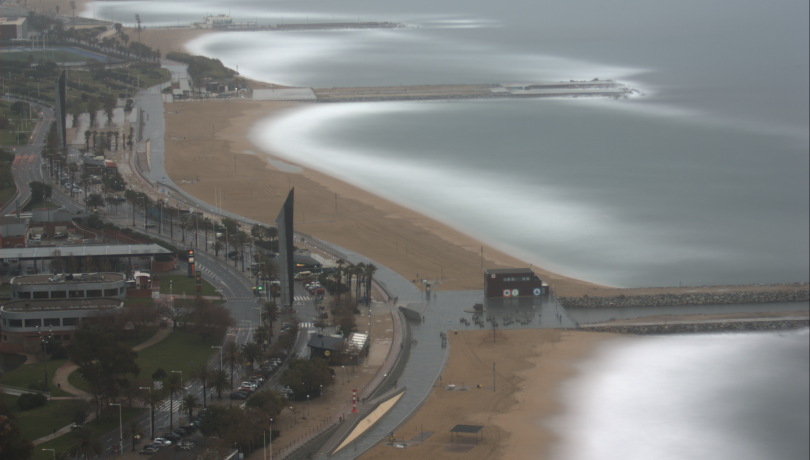The ICM researcher explains why Barcelona's beaches are in danger and which solutions could help reverse this situation.

Today we interview the ICM researcher Jorge Guillén, an expert in the study of the morphodynamics of coastal areas. He is a geologist by profession, and his research focuses on monitoring the short- and medium-term evolution of sediment and sedimentary structures.
How have Barcelona's beaches changed in recent years?
Their configuration has changed significantly. New protective structures, such as groins and jetties, have created new beaches and changed the shape of the existing ones. Nowadays, all of them are now affected by a progressive loss of sand, which is only partially compensated by artificial sand nourishment. The loss of surfaced beach area varies greatly, but in Barcelona it is about 500 m2/year on each beach, which has meant that over the last 20 years more than 1 million cubic metres of sand have been artificially deposited.
Which is the reason for this decline?
The main reason is the absence of natural sand inputs that could balance the losses that have occurred during storms. The intensity of this imbalance depends on many factors, such as the orientation or the degree of protection of the beach. In particular, groins construction on the coast reduces the capacity of sand to be transported from one beach to another by the waves. In contrast, detached breakwaters –that are separated from the coast- reduce the transverse transport of sediment and the loss of sand during storms.
Where does the sand that is artificially dumped come from?
It comes from other areas of the Catalan coast, either from the dredging of harbour mouths or from some sand deposits. The problem is that the amount of sand available is very limited and its use should be limited as much as possible, both to avoid the environmental damage caused by its extraction and dumping, and to maintain the sand deposits as a strategic reserve for exceptional situations.
Which other solutions could prevent beaches from continuing to retreat?
Barcelona's beaches will continue to show an erosive trend that could lead to their disappearance in a relatively short period of time if no action is taken. To reverse this situation, we must try to keep the erosion trend as low as possible by optimising all available resources, including sand transfers and early warning systems to avoid the impact of storms. We must also incorporate urban areas into the beach whenever possible and "fabricate" flood zones that limit risk and capture sediment.
What is Barcelona City Council doing to prevent this?
The City Council is closely monitoring the evolution of the beaches and their environmental state, both in the dry and the submerged part, with the aim of applying measures to help reduce their vulnerability. In addition, a group of experts that includes several ICM researchers has been set up to discuss the future of Barcelona's beaches and propose possible solutions or alternatives. Among the proposals so far are the extension of the inner areas of the beaches and the implementation of preventive systems to develop adaptation strategies.
What are the possible consequences of the extension of groins such as the one at Sant Sebastià beach?
Although Barcelona's beaches are artificial and highly protected, the aim of extending the groins is to try to reduce sediment loss as much as possible. In addition to Sant Sebastià beach, some sections of Nova Marbella and Barceloneta beaches are particularly sensitive to erosion, so the aim is also to reinforce protection at these points. However, in the future, rising sea levels will probably make it necessary to reinforce most of the coastal structures.
What is being done in other places with similar beach dynamics?
Unfortunately, erosion problems affect a large part of the world's beaches, due to both natural processes and climate change, and there are no miracle solutions beyond optimising sediment management, extending the public maritime-terrestrial domain and reinforcing protective structures. We must change our perspective and not imagine future beaches as we see them now. They will be different beaches, for sure, but we can influence and determine the type of coastline we want. At the ICM we are researching the long-term changes that will occur over the next few decades, both on sheltered and open beaches, in order to improve their adaptation and resilience to the new conditions.
What role does climate change play in all this?
The greatest impact on beach morphodynamics associated with climate change is from sea level rise and, in some areas, increased storm intensity. In both cases, the beach responds by retreating. So far, the main cause of beach retreat has been human intervention, which has reduced sediment inputs and taken up space that previously belonged to the beach. However, in the coming years, rising sea level will be the main cause of beach retreat.
What can the citizens do?
Obviously, we can all minimise these impacts: it is not the same for sea level to have risen by 20 centimetres by 2100 as it is to have risen by 1 metre; the consequences will be radically different. Furthermore, we have the opportunity, although we have not chosen it, to design the coastline we want in the future, and we must do so without mortgaging future generations and thinking of solutions that are as sustainable and respectful as possible with nature.